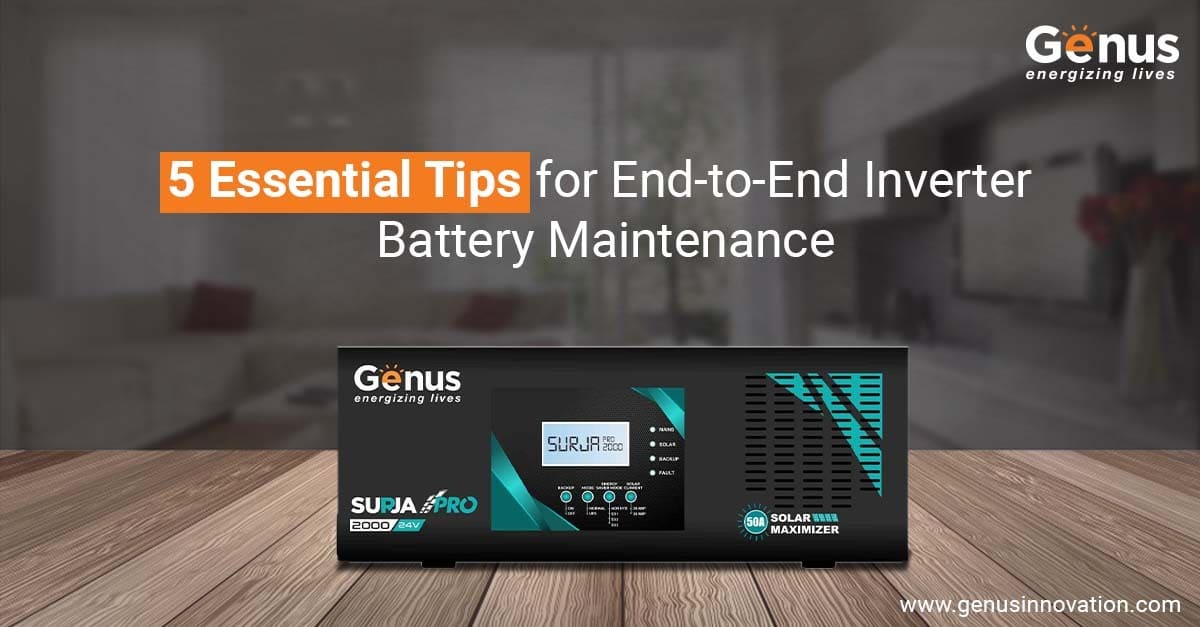
To ensure longevity and peak performance, routine inverter battery maintenance and upkeep are a must. Because let’s face it; battery is the lifeline of any inverter, and a damaged battery means unreliable power supply, and sometimes, even complete failure. Regular servicing of your inverter battery for home ensures that you don’t face these pitfalls.
But if you don’t know your way around an inverter battery, here are 5 useful tips to ensure that your inverter stays on top of its game.

5 Effective Tips for Inverter Battery Maintenance
1. Always Keep the Water Topped Up
Every two months, check the water level of the battery to ensure it hasn’t fallen below the maximum specified limit. Having less water means there’s less electrolyte in the battery, which can hamper its power storage and delivery capacity. So, top up the water level every couple of months during your inverter battery maintenance to ensure sufficient power supply during outages.
Also, don’t use tap water during refills, as these contain many impurities. Go for distilled water.
2. Clean the Terminals
Battery terminals are susceptible to rust and corrosion, which can severely affect the inverter’s current flow capacity. This restricted current flow, in turn, leads to slow charging of the capacitor plates, and ultimately, a reduced battery life. So, if the battery terminals of the solar inverter battery are forming rust, pour a solution of baking soda and hot water on the corroded portion, or use a toothbrush to scrape off the corroded part.
Once the terminals are clean, use Vaseline or petroleum jelly to avoid further corrosion.
3. Check the Battery only when Fully Charged
Before conducting a maintenance check, make sure it’s fully charged. So, ensure that the battery’s been plugged in for a good 10-15 hours before you start the inverter battery maintenance. Also, begin the inverter battery maintenance only after the front panel of your inverter is removed, and is also detached from the wall socket.
4. Make Sure the Battery Isn’t Overloaded
Outside the scheduled maintenance, you can also take steps during daily inverter use to elongate its lifespan. For instance, during a power outage, the inverter uses the power that’s stored in the battery to power up the appliances. And if the battery is overloaded during a power cut, it would cut short the backup time.
Therefore, it’s best to power on only essential devices during a power cut. It will increase the battery backup, and also improve its longevity.
Talking about longevity, for the best performance, durability, and reliability, opt for solar products in India by Genus Innovation.
5. Other Maintenance Tips
Ensure that the vents surrounding your battery are open and dust-free. Blocked vents can cause hydrogen gas accumulation, which can lead to the bursting of your battery.
Also, for the utmost safety, install the inverter in such a way that it’s out of reach for your children. But at the same time, make sure the inverter is properly ventilated.
Lastly, if your battery is damaged, or downright dead, it may be time to replace it. If you conduct proper checks regularly, you’ll know when your inverter battery is up for replacement.
Over to You
With these tips in your inverter battery maintenance tips, you can ensure that your inverter battery provides you with optimum efficiency, performance, and durability.
If you’re looking for top-of-the-line inverter batteries, UPS, or solar products, with long life and optimum performance, Genus Innovation has the right solutions for you! Get in touch with us today to know more about our battery and solar solutions.
